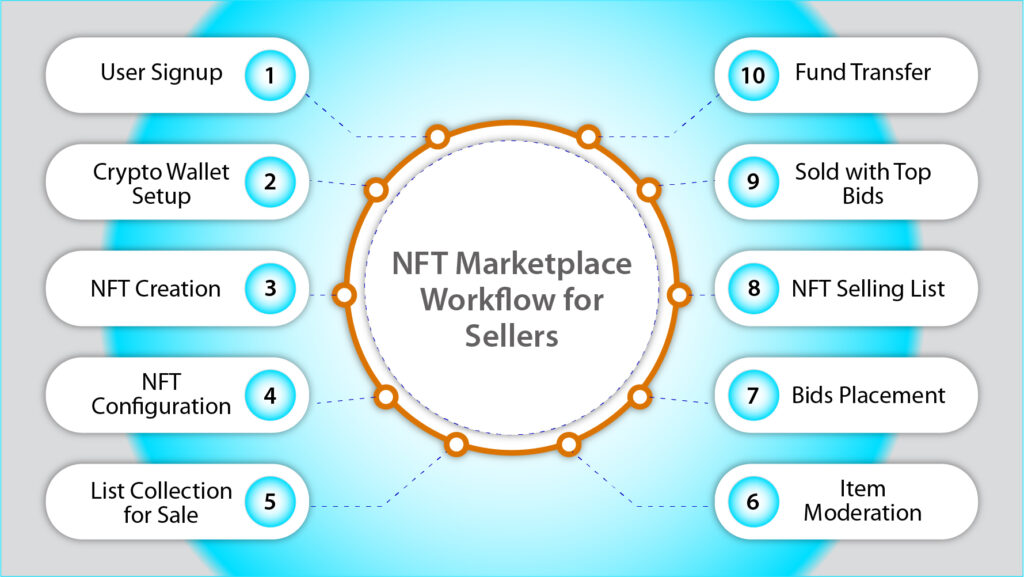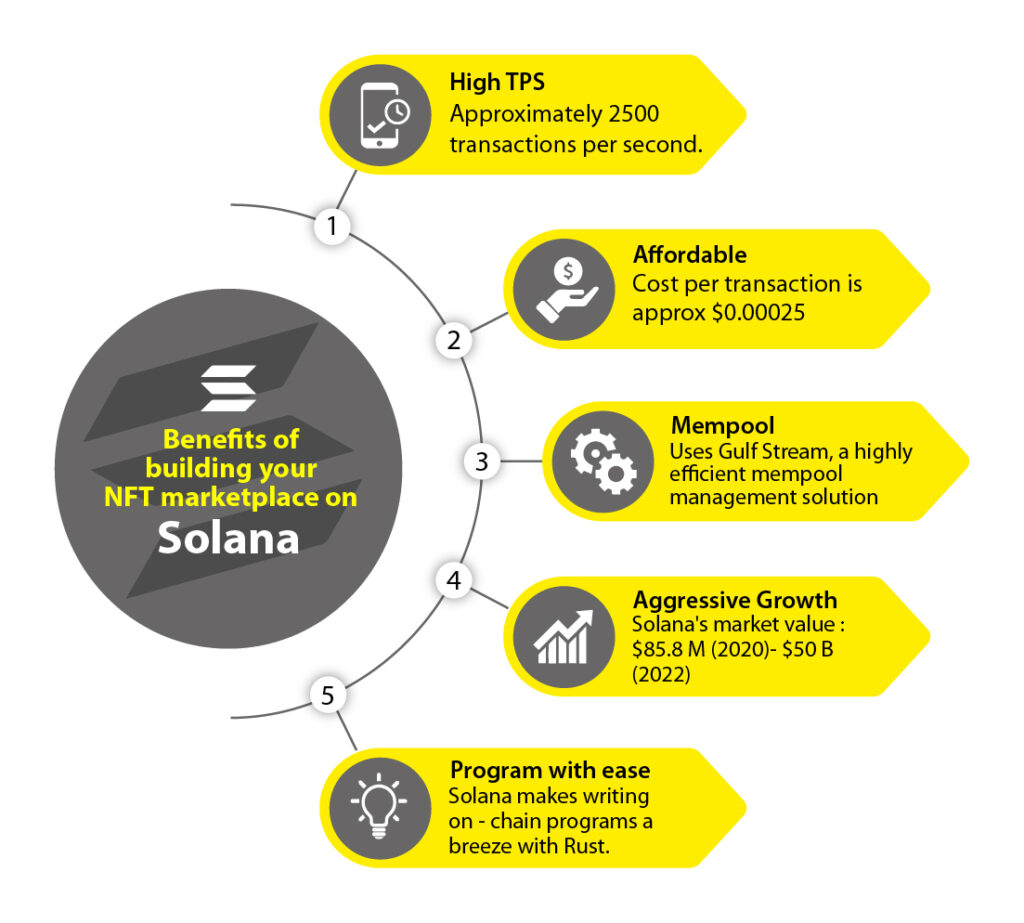NFTs have become a significant asset class, with the market growing from $100 million in 2020 to $22 billion in 2021. This surge in popularity is seen among creators and collectors worldwide.
Industries like music, entertainment, and consumer products are actively exploring ways to capitalize on the NFT trend. Some prefer third-party platforms for cost-effectiveness and customer access, while others value the control of owning an NFT marketplace.
Building on Solana is emphasized for NFT market development, offering a step-by-step guide. Understanding NFT and Solana fundamentals is crucial before delving into the Solana NFT marketplace development guide.
Contents
- 1 Key Points for Solana NFT
- 2 Understanding NFT Marketplaces: A Gateway for Digital Asset Trading
- 3 Essential Features for an Optimal NFT Marketplace Experience
- 4 Leveraging Solana for Your NFT Marketplace: Advantages and Features
- 5 A Step-by-Step Guide to Creating a Solana NFT Marketplace Development
- 5.1 Creating a Solana NFT marketplace involves several steps, from defining your marketplace requirements to marketing your finished product. Here’s a step-by-step guide:
- 5.2 Step 01: Creating and Funding an SOL Wallet
- 5.3 Step 02: Forking and Cloning the Metaplex Repository
- 5.4 Step 03: Changing the Deployment Github Address
- 5.5 Step 04: Setting up and Deploying the NFT Marketplace
- 6 Frequently Asked Questions
- 6.1 What Are the Benefits of Using Solana for NFT Marketplace Development Compared to Other Blockchain Platforms?
- 6.2 How Does the Solana NFT Marketplace Ensure the Authenticity of the NFTs Being Sold?
- 6.3 Is it Possible to Integrate Multiple Payment Methods into a Solana NFT Marketplace?
- 6.4 Can Creators Set Their Own Royalties for their NFTs on the Solana Marketplace?
- 6.5 How Does the Solana NFT Marketplace Handle Disputes Between Buyers and Sellers?
- 7 Conclusion
Key Points for Solana NFT
Solana is a high-performance blockchain that supports fast transaction speeds and low fees, making it an attractive platform for NFT development. Here are some key points about Solana NFTs:
- Solana is a popular platform for NFT creation and exchange due to its fast transaction processing times and low fees.
- Robust marketplace software on Solana is important for handling large numbers of NFT transactions efficiently.
- Solana-based NFTs are gaining popularity due to their faster transaction speeds and lower costs compared to other blockchain platforms.
- Scalability is crucial when designing Solana NFT marketplace software for high traffic volumes without compromising performance, reliability, and availability.
Understanding NFT Marketplaces: A Gateway for Digital Asset Trading

NFT marketplaces, similar to e-commerce platforms, enable the exchange of goods. However, these marketplaces focus exclusively on digital assets known as NFTs, distinguishing them from platforms dealing with physical products.
Their primary function revolves around facilitating the buying, selling, and trading of digital collectibles and assets. To ensure a seamless user experience, developers of NFT marketplaces incorporate globally accepted and recommended features into their platforms.
These essential features are designed to eliminate obstacles and streamline the trading process for NFT enthusiasts.
Essential Features for an Optimal NFT Marketplace Experience
Solana uses a unique consensus algorithm called Proof of History (PoH), which allows for high throughput and low latency.
To develop Solana NFTs, you need to understand the basics features of the Solana NFT marketplace. Those are:
1. Crypto Wallet Integration
A crypto wallet serves as a crucial element within an NFT marketplace, enabling secure transactions. Seamless synchronization between the user’s crypto wallet and the marketplace is essential. Popular NFT wallets like Metamask and Coinbase are widely recognized for their compatibility.
2. Shop Window Display
NFTs listed on a marketplace should provide comprehensive information, including price, owner details, descriptions, and preferred payment methods. Marketplaces equipped with an attractive and informative shop window have higher potential for driving sales.
3. Streamlined Registration Process
An efficient search engine is vital for users to quickly locate NFTs related to music, videos, or photography. The search algorithm should interpret user intent and present real-time, accurate information.
4. User History Tracking
Comprehensive user management features allow NFT marketplaces to record, store, and display trading data, transaction history, and a record of approved, purchased, and sold NFTs. A transparent user history system enhances user engagement and platform trust.
5. Alerts and Notifications
NFT marketplaces should have the capability to send alerts and notifications to users based on their transaction and search history. Instant notifications about new listings empower users to make timely decisions.
6. Customer Support
A robust customer support system, featuring chat/live call assistance or a knowledge center, ensures prompt and effective resolution of user queries and concerns.
By incorporating these essential components, an NFT marketplace can deliver a seamless trading experience to users. Now that you have an understanding of the marketplace structure, let’s delve into why Solana should be your preferred platform for NFT marketplace development.
Leveraging Solana for Your NFT Marketplace: Advantages and Features

Solana, an open-source blockchain network, offers a revolutionary PoH consensus model that accelerates transaction processing. Designed to support decentralized and scalable applications, Solana surpasses legacy blockchains like Ethereum in terms of speed and gas fees.
It has become a preferred choice for entrepreneurs, investors, and content creators, not only for NFT creation but also for building NFT marketplaces. Let’s examine the advantages a Solana-based NFT marketplace can bring to your business.
Impressive Transactions per Second (TPS)
With the ability to process around 2500 transactions per second, Solana showcases remarkable speed, ensuring instant completion of transactions on any NFT marketplace. It’s important to note that TPS is a dynamic metric subject to change.
Low Cost Per Transaction
Solana’s high throughput and low transaction fees of $0.00025 make it an ideal platform for NFT creation and NFT marketplaces of various sizes. It offers cost-efficiency without compromising performance.
No Mempool Issues
Solana eliminates mempool issues, the waiting area for processed transactions. This feature enables instant transactions on Solana-based NFT marketplaces, ensuring seamless user experiences.
Expanding Ecosystem
The Solana ecosystem continues to grow, facilitating the handling of multiple decentralized applications (dApps), smart contracts, and coins without network congestion. It provides a scalable environment for your NFT marketplace to thrive.
Simplified Programming
Solana employs Rust software, making programming and creating diverse applications easier. Its flexibility empowers you to build NFT marketplaces, dApps, and other innovative solutions effortlessly.
By leveraging Solana’s strengths, you can unlock the potential of your NFT marketplace, offering fast transactions, cost-effectiveness, scalability, and streamlined development.
A Step-by-Step Guide to Creating a Solana NFT Marketplace Development
Creating a Solana NFT marketplace involves several steps, from defining your marketplace requirements to marketing your finished product. Here’s a step-by-step guide:
Step 01: Creating and Funding an SOL Wallet
Begin by creating a browser wallet compatible with Solana. Choose a suitable platform and create the wallet. Then, fund your wallet with SOL tokens.
Step 02: Forking and Cloning the Metaplex Repository
Fork the Metaplex repository to your Github account for easy hosting on Github pages. Copy all the Metaplex files onto your system.
- Create a folder on your desktop and give it the name “myNftMarketplace”.
- Copy the location/path of the folder.
- Navigate to the folder in the command line by changing the directory.
“cd /Users/yourusername/Desktop/myNftMarketplace”
Now, clone the Metaplex repository into the folder you created:
“git clone https://github.com/yourusername/metaplex.git”
Performing these steps will assist you in setting up a repository in your GitHub account by cloning all the files from the Metaplex repository into your designated folder.
Step 03: Changing the Deployment Github Address
- Modify the deployment address by replacing it with your Github username.
- Change the wallet address of your store to add the public address of your browser wallet, granting administrative access.
Step 04: Setting up and Deploying the NFT Marketplace
- Change the directory to the js folder using the command: “cd metaplex/js.”
- Install dependencies by running the command: “Yarn”
- This command downloads the necessary dependencies. To check if all dependencies are working correctly, run: “yarn bootstrap”
- Test your NFT marketplace locally with: “yarn start”
- To build the project files, use: “yarn build”
- Change the directory to the web folder: “cd packages/web”
- Finally, deploy the marketplace with: “yarn deploy”
This deploys the marketplace to your Github repository, making it live on the Solana blockchain.
Frequently Asked Questions
What Are the Benefits of Using Solana for NFT Marketplace Development Compared to Other Blockchain Platforms?
The benefits of using Solana over other blockchain platforms for NFT marketplace development include its high scalability, fast transaction processing speed, low fees, and strong security features.
These factors make it a more efficient and cost-effective option for managing large volumes of transactions and maintaining the integrity of digital assets.
How Does the Solana NFT Marketplace Ensure the Authenticity of the NFTs Being Sold?
The authenticity of NFTs in a marketplace can be ensured through verification by trusted third-party sources, metadata analysis, and blockchain technology. Solana’s fast and secure network can facilitate these processes efficiently.
Is it Possible to Integrate Multiple Payment Methods into a Solana NFT Marketplace?
Integrating multiple payment methods into an NFT marketplace is possible, but requires careful consideration of security and user experience. Factors such as transaction fees and ease of use must be balanced to provide a smooth and secure buying experience for users.
Can Creators Set Their Own Royalties for their NFTs on the Solana Marketplace?
Creators can set their own royalties for their NFTs on various blockchain-based marketplaces, including Solana. This allows them to earn a percentage of the resale value each time the digital asset changes hands, ensuring they benefit from its increasing value over time.
How Does the Solana NFT Marketplace Handle Disputes Between Buyers and Sellers?
Disputes between buyers and sellers in NFT marketplaces can be handled through various mechanisms, including mediation or arbitration. The Solana NFT marketplace may have its own dispute resolution process, which would likely involve a neutral third party to help resolve conflicts.
Conclusion
NFTs have gained immense popularity, driving the growth of global transactions involving them. The rising demand for NFT marketplaces stems from the recognition of their potential as lucrative investments.
To succeed, your NFT marketplace must offer quality and attract users. When choosing a blockchain for development, consider Solana for its scalability and feature-rich nature. With its smart architecture, Solana provides both excellence and affordability.
If you’re seeking experienced developers for a robust NFT marketplace, reach out to us. Our experts can assist you in capturing the expanding NFT market.

